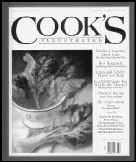COOK’S ILLUSTRATED $24.95 (six issues)
2001 COOK’S ANNUAL $26.95 (six issues hardbound) COOK’S ANNUAL 1993-2001 $179.95 (nine volumes; index $12.95), 800-611-0759 or www.cooksillustrated.com
WITH ANY LUCK, the political and economic catastrophes surrounding us will have at least one minor upside: a temporary end to Faberg頦ood. Those teased, tweaked encastellations of recherch頩ngredients towering up from miniature moats of pur饠always verged on the nauseous. Now that vertical arrogance in general has been exposed as hollow, they look nastier than ever.
During the hyperextravagant ’90s, one hardly noticed that a kind of counterrevolution was already under way. I’m not talking about comfort food: Those $59 plates of macaroni and cheese or meat loaf were already turning up on menus before the crashes, metaphorical and otherwise. I mean a genuine, puritan campaign against the cult of personality as applied to food and the kind of desperate fanciness it leads to on the plate.
I can’t recall how I first became aware of Cook’s Illustrated. Perhaps a friend gave me a xerox of a CI recipe—for brining a chicken, was it, or seafood bisque?—striking for its combination of common sense and defiance of convention. Both qualities are central to almost every article CI publishes in its 32 advertising-free bimonthly pages.
Cook’s Illustrated is published by Boston Common Press of Brookline, Mass., and everything about it—from its no-nonsense prose to publisher-editor Christopher Kimball’s bow ties—exudes an almost parodic Yankee spirit. If R.W. Emerson, Hank Thoreau, and their crowd had been gustatorily rather than transcendentally oriented, this is the kind of magazine they would have produced.
In the test kitchens of Cook’s Illustrated, nothing is sacred. Even as basic a dogma as the superiority of fresh to processed ingredients is incessantly challenged, with sometimes startling results. Never mind using expensive whole dried vanilla beans in your ice cream or custard, for instance; once cooked, plain bottled true vanilla extract tastes just as good.
These dicta are not issued ex cathedra. Before CI lays down the law on even the simplest dish—yes, even mac ‘n’ cheese—its experts have stripped down the recipe to its smallest components, polished and buffed each to a high gloss, and tested the operation at every stage of reassembly. When CI finally expresses satisfaction with its approach to ratatouille, you can be sure that bushels of tomatoes, gunnysacks of onions, and whole shopping cartsful of eggplant have been sacrificed on the way to perfection.
As befits results so strenuously achieved, CI does not merely issue and forget reports on its research; all six annual issues of the magazine are collected into a meticulously indexed hardcover volume for future reference. Nine such volumes are currently in print, available singly or as a set from the CI Web site. For further convenience, a freestanding index to the whole impressive affair is available to simplify your search for the perfect recipe for virtually anything Americans cook frequently.
SURROUNDING THE central system of Cook’s Illustrated is an even more impressive nimbus of other publications purporting to give the last word on almost any culinary subject, from appetizers to desserts. So far as I have delved into these volumes, they appear uniformly as well researched and edited as their magazine counterparts. But enthusiasts should take care not to purchase too freely. With true New England thriftiness, the editors of CI waste nothing, so the recipe for hearty beef stew you liked so much in the January ’96 issue is almost certain to recur with only marginal revisions in the separate volume titled Soups and Stews.
The value of Cooks Illustrated for serious kitchen engineers extends well beyond the nuts and bolts of recipes. Every issue includes Consumer Reports-style reviews of kitchen appliances and other gear. Since the magazine accepts no advertising, its evaluations of name brands—major and minor—can be savage, and often are. If your kitchen is not already replete with blenders, food choppers, waffle irons, etc., CI reviews will save you enough money and grief to pay for itself before a year’s subscription runs out.
The same applies to the magazine’s bimonthly survey of just-published cookbooks. Nothing, no matter how famous the name on the cover, gets an approving nod until the CI team has tried out its recipes for accuracy and ease of use. If you’re someone who actually uses cookbooks rather than just accumulating them like amulets, this feature, too, will save you untold disappointment and frustration.
Cook’s Illustrated of course has a television arm, titled America’s Test Kitchen (airing at 3:30 p.m. Saturdays on KCTS 9; the second season began Jan. 12). Though the show is blessedly free of the yelling, leaping, and gouts of flame typical of many cooking programs today, I confess I find it almost comic—an unintentional parody of the dry, plodding qualities that make the magazine so useful. The 10th or 11th time someone insists on showing you five bad ways to cook something before revealing the right one, it gets a little old.
Or maybe it’s just Kimball’s bow tie. In the books, I don’t have to look at it wobble.








